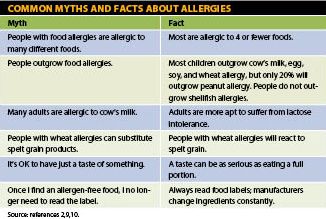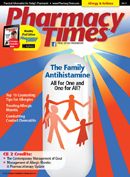Publication
Article
Pharmacy Times
Top 10 Counseling Tips for Allergies
Author(s):
Whether patients are coping with allergies caused by seasonal, nonseasonal, or food allergens, pharmacists can help patients prevent and manage their bothersome symptoms.
Whether patients are coping with allergies caused by seasonal, nonseasonal, or food allergens, pharmacists can help patients prevent and manage their bothersome symptoms.
Like an unwelcome guest, many allergens arrive with little warning. Their most common effects are all too familiar to the millions suffering from allergies: itchy nose, eyes, and roof of the mouth; runny or stuffy nose; watery eyes; sneezing; ear fullness and popping; hives; cough; and sinus headache. Allergies are either seasonal (eg, caused by tree and plant pollen) or nonseasonal (eg, caused by dust). Mold, animal dander, dust, and pollen are the most common allergens.
Food Allergies
Many studies suggest food allergies have increased in the past 10 to 20 years. Nevertheless, food allergies are frequently confused with other conditions; up to 90% of those with presumed food allergies do not have true food allergies. 1 In December 2010, the National Institute of Allergy and Infectious Diseases released its first guidelines diagnosing and managing food allergies, which can be found on the agency’s Web site (www.niaid. nih.gov). Also, the FDA now requires manufacturers to list 8 major food allergens in plain English (eg, “milk” instead of “casein”). 2
Counseling Patients with Allergies
Patients often self-treat mild to moderate allergies, asking pharmacists for guidance about which OTC antihistamines, decongestants, combination products, or nasal sprays work best. Effective counseling must be patient specific; however, there are counseling tips that apply to all patients, including parents with children experiencing allergies.
Tip 1. Identify the culprit.
Although most people are aware of seasonal allergies, many cannot pinpoint the culprit. Keeping a log regarding symptom onset, time of day, and environmental surroundings helps narrow the list. Patients’ symptoms often vary in intensity from day to day, further complicating assessment. Patients with ongoing allergies should see a specialist, even if symptoms are mild. The intensity of current allergic reactions does not necessarily predict the intensity of future attacks.
Tip 2. Review things that can worsen symptoms.
Although patients may attempt to avoid allergens’ triggers, they may be unaware of exacerbating environmental conditions, including aerosol sprays, air pollution, cold temperatures, humidity, irritating fumes (including perfume), tobacco and wood smoke, and poor housekeeping. 3
Tip 3. Discuss changes patients can make to minimize symptoms (see Table 1).
Tip 4. Educate patients on the difference between food intolerance and food allergies.
Many people confuse food allergies with more common food intolerances. Allergies involve an immune reaction; food intolerances stem from the inability to digest certain foods. Symptoms are similar, but milder: gastrointestinal problems, hives, itching, or eczema. 5 Although avoiding specific foods is the recommended strategy, patients should be evaluated by an allergist.
Tip 5. Discuss anaphylaxis.
Those with severe reactions have increased risk for anaphylaxis. 6 Inform patients they need to call 911 or go to the emergency department (ED), if
• acute symptoms occur within minutes or hours involving respiratory compromise, tongue swelling, or hypotension
• skin tone is flushed or pale (almost always present with anaphylaxis)
• nausea, vomiting, or diarrhea begins
•dizziness or fainting, or a weak or rapid pulse, occurs. 6,7
Certain medications (especially penicillin); foods like peanuts, fish, shellfish, milk, and eggs; and insect stings are common triggers for anaphylaxis. 7
Emphasize to parents that a history of mild reactions does not preclude the child from having a future anaphylactyic reaction. Treatment starts with epinephrine, followed by antihistamines or corticosteroids. Using an epinephrine pen does not eliminate an ED visit; the severity of anaphylaxis is difficult to predict.
Tip 6. Review cross-reactivity.
Cross-reactivity—allergic reaction to 1 item in a food group resulting in an allergic reaction to other items in the same food group—is common. People allergic to shrimp are also prone to be allergic to other shellfish. Cross-reactivity is less common in animal food groups. A person allergic to eggs or milk will not usually have a reaction to beef or chicken. 2
Tip 7. Address unproven treatments.
A quick Internet search uncovers a host of unproven diagnostics and treatments for allergies, including hair analysis, acupuncture, and herbal medicine. Most lack adequate studies and some, such as “cytotoxic” food testing (mixing blood with a food extract to determine if the cells swell), make no sense given current knowledge of the immune system. 8 Unproven treatments are not necessarily harmless; some can do real harm. Discourage patients from trying these treatments without first discussing them with their physician.
Tip 8. Probe for comorbidities.
Many allergies, especially food allergies, tend to coexist with other conditions, including asthma, atopic dermatitis, and eosinophilic esophagitis. Allergy treatments may improve some of these other symptoms. Pharmacists should routinely query about asthma when counseling on allergies.
Tip 9. Address patients’ misconceptions.

Many patients have misconceptions about food allergies. Table 2 highlights some common myths and realities.
Tip 10. Review side effect profiles.
The American Academy of Allergy, Asthma, & Immunology maintains a comprehensive allergy and asthma drug guide (www.aaaai.org) that lists drug class, use and dosage, product links, common side effects, and precautions.11 Patients using antihistamines for the first time need to be counseled about their sedating effects and to refrain from driving or using dangerous equipment until they know how the antihistamines will affect them.
Final Thought
When dealing with allergies, prevention is the optimal strategy, albeit a challenge. When prevention fails, effective pharmacist counseling for symptom management is critical. PT
Dr. Zanni is a psychologist and health systems consultant based in Alexandria, Virginia.
References
1. Boyce JA, Assa’ad A, Burks AW, et al; NIAID-sponsored expert panel. Guidelines for the diagnosis and management of food allergy in the United States: summary of the NIAID-sponsored expert panel report. J Allergy Clin Immunol. 2010;126:1105-1118.
2. The American Academy of Allergy Asthma & Immunology. Tips to remember: food allergy. http://www.aaaai.org/patients/publicedmat/tips/foodallergy.stm. Accessed February 26, 2011.
3. Allergies: things you can do to control your symptoms. FamilyDoctor.Org. http://familydoctor.org/online/famdocen/home/common/allergies/basics/083.html. Accessed March 10, 2011.
4. Asher I, Baena-Cagnani C, Boner A, et al; World Allergy Organization. World Allergy Organization guidelines for prevention of allergy and allergic asthma. Int Arch Allergy Immunol. 2004;135:83-92.
5. What is the difference between food allergy and food intolerance? Medical News Today. www.medicalnewstoday.com/articles/12926.php. Accessed March 11, 2011.
6. Peavy RD, Metcalfe DD. Understanding the mechanisms of anaphylaxis. Curr Opin Allergy Clin Immunol. 2008;8:310-315.
7. Mayo Clinic Staff. Anaphylaxis. www.mayoclinic.com/health/anaphylaxis/DS00009. Accessed March 11, 2011.
8. The Auckland Allergy Clinic. Alternative (unproven) allergy tests and treatment. www.allergyclinic.co.nz/guides/4.html. Accessed March 11, 2011.
9. Myths and facts about food allergies. American Family Physician. www.aafp.org/afp/2006/1201/p1919.html. Accessed March 10, 2011.
10. How to cope with a food allergy? Health Information Publications. http://ehealthmd.com/library/foodallergies/fa_coping.html. Accessed February 26, 2011.
11. The American Academy of Allergy Asthma & Immunology. Allergy and asthma medication guide. www.aaaai.org/patients/resources/medication_guide.asp. Accessed March 10, 2011.







